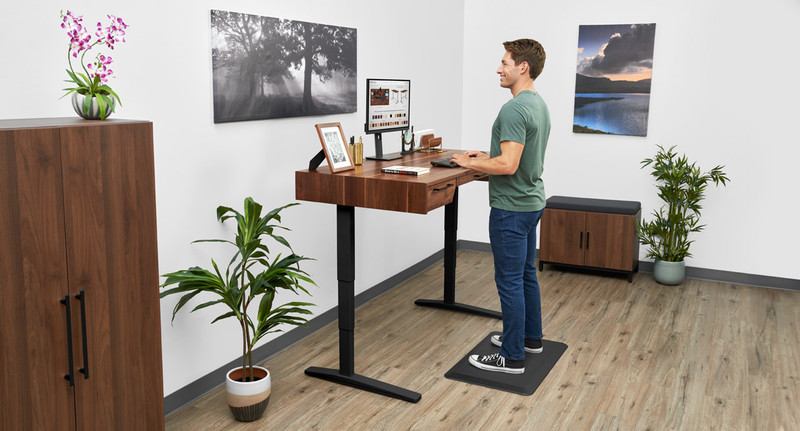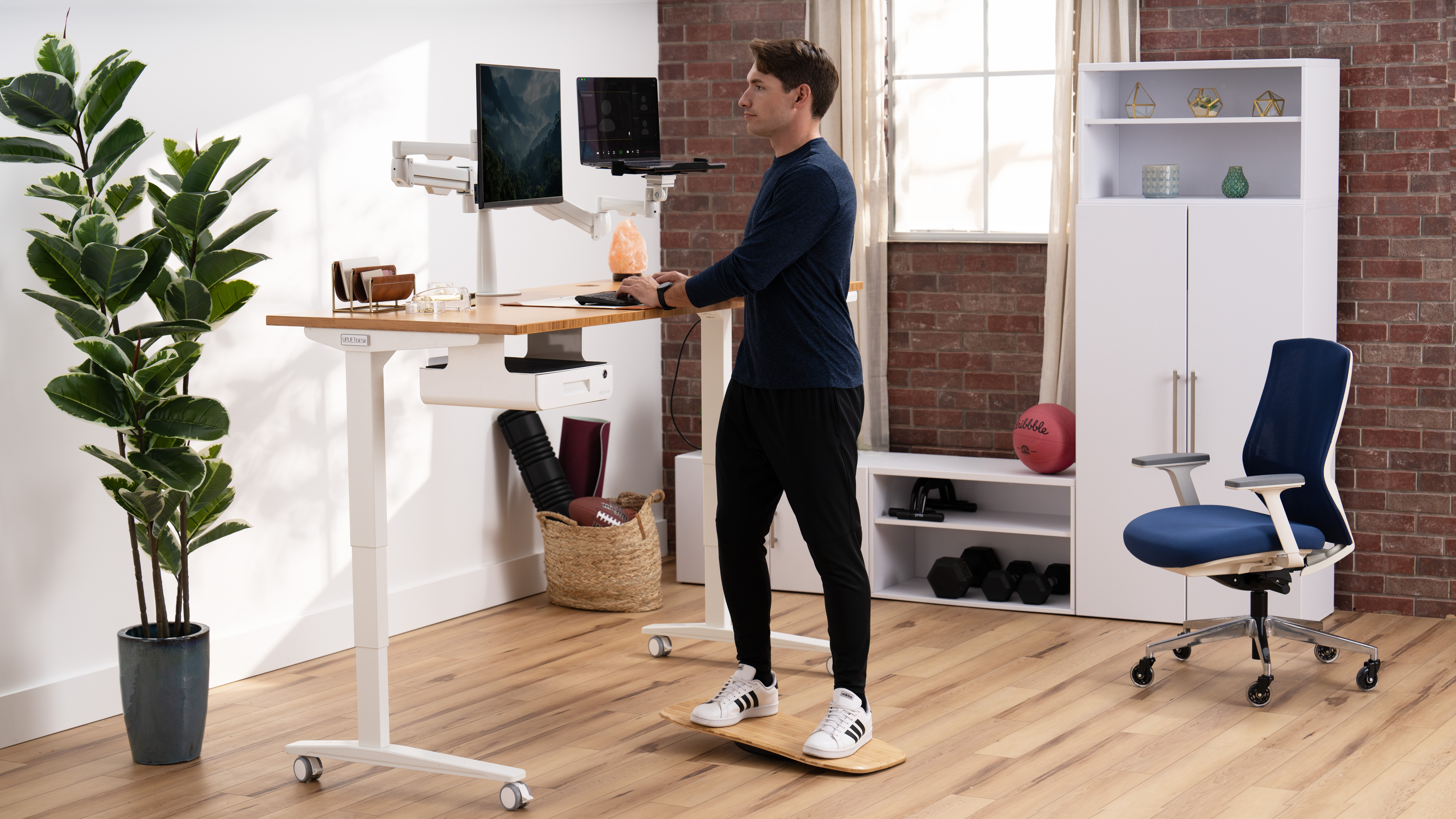
Health Benefits of Using a Standing Desk
You may have heard the phrase “sitting is the new smoking.” Considering cigarettes are a known carcinogen, that may seem like a stark comparison, but there might be some truth to it. More than 80% of jobs in the United States involve mostly sedentary activities, not to mention long commutes. All this to say, physical activity is paramount to overall health, and prolonged occupational sitting isn’t doing you any favors.
Using a standing desk can balance out the sedentary nature of most jobs. But you may wonder: Are there actually health benefits of a standing desk, or are the purported advantages overhyped? We asked medical professionals if the rumors are true and took a deep dive into the research to find out. Here’s what the evidence says about standing desk benefits.
Prolonged Sitting Can Have Negative Health Effects
First thing’s first: Why not sit for most of the day? You could, but you should at least know the risks.
“Sitting for long periods, especially in front of a computer, can have a significant impact on your body,” says Gbolohan Okubadejo, MD, a spinal and orthopedic surgeon in New Jersey and New York. “When you stay in the same seated position for hours, your muscles—especially in the back and hips—can get tight and weak, which can lead to poor posture and chronic back pain over time.” All this sitting can also weaken your core muscles, putting a strain on your spine, Dr. Okubadejo says.
Prolonged sitting can even increase the risk of chronic diseases and mortality. “Physical inactivity is a leading cause of death and contributing risk factor to heart disease, type 2 diabetes, and some cancers,” explains Richa Mittal, MD, a board-certified obesity medicine doctor in Frisco, Texas. This aligns with findings from a 2024 study.
What about mentally? A sedentary lifestyle has been correlated to rates of depression, research has found.
Simply put, prolonged occupational sitting is harmful to health, Dr. Mittal says. Fortunately, there’s plenty you can do to mitigate these risks.
7 Standing Desk Benefits
Sitting for an entire workday isn’t great for your health, but are standing desks good for you? Here’s what the evidence supports.
-
1. Reduces Back, Neck, and Shoulder Pain
When you sit at a regular desk, you may not even realize you’ve adopted what’s called a forward head posture—this is when the head protrudes forward instead of remaining neutral with the spine. Forward head posture is a common cause of neck and shoulder pain among office workers, but standing desks may help. A 2024 study demonstrated that standing desks encourage proper spinal alignment, taking pressure off the muscles and reducing neck and shoulder pain.
There’s a similar link between standing desks and reduced back pain. If you’ve ever had back pain, you may have found that standing makes it worse, but don’t fret. In a 2020 study, people with standing-induced lower back pain experienced relief when using a sit-stand desk and increased their tolerability to standing.
How does this simple effort to stand more make such a noticeable difference in people’s pain? We asked an orthopedic surgeon. “Standing more helps alleviate pressure on your lower back by promoting better posture and spinal alignment,” Dr. Okubadejo explains. “Standing also allows your muscles to engage and stretch naturally, reducing stiffness, and helps keep your weight more evenly distributed, alleviating tension in the neck, shoulders, and lower back.”
-
2. Encourages Good Posture
If you have a lot of aches and pains related to your desk job, it could be due to poor posture. It’s not your fault—most office setups aren’t designed with ergonomics in mind, so they end up putting a strain on your spine. That’s where standing desks come in: “They encourage better posture by helping you avoid slouching and reducing pressure on the lower back,” Dr. Okubadejo says. “An ergonomic workspace is important because it supports the body's natural spinal alignment.” This can translate to less muscle and joint pain, he says.
It may seem small, but good posture is an underrated aspect of overall health. Research shows that sitting alters your spinal curvature in favor of a C-shaped profile and changes the position of your pelvis. What’s the big deal? Not only does this affect your center of gravity, it puts unnecessary load on the spine and weakens your abdominal muscles, contributing to discomfort and stiffness.
-
3. Increases Circulation
You may not be able to see it, so it often goes unappreciated, but your blood circulatory system is constantly at work. It delivers nutrients and oxygen throughout the body while also removing waste. Cardiovascular exercise is one way to get your blood pumping, but standing more often can help too. “Sitting for too long slows down your circulation, which can increase your risk of blood clots and heart problems,” says Dr. Okubadejo.
Research tells us that we should break up long periods of sitting with bouts of standing and walking to improve blood flow—the researchers even mentioned incorporating a sit-stand desk to reap these benefits. There’s also evidence that prolonged sitting impairs blood flow to and from your legs, suggesting we should all get up every so often to make sure our blood can circulate properly.
-

4. Regulates Blood Sugar
Sugar gets a bad rap, but let’s remember that glucose is the body’s preferred source of energy. There’s a catch though—the amount of glucose in your blood (aka your blood sugar) needs to be just right for the body to function properly. Physical activity is one of the many factors that influences blood sugar, but even standing more throughout the day can have a positive impact.
Here’s how it works: When you eat, your body breaks down the food into glucose, which enters your bloodstream. This causes your blood sugar levels to rise, prompting your pancreas to release insulin, a hormone that helps cells absorb glucose from the bloodstream for energy or storage. This process is known as the uptake of glucose, and large muscle groups play a starring role in it. “Standing desks help regulate blood sugar by allowing for muscle contractions to help uptake of glucose into the muscles,” Dr. Mittal says. “When seated, the muscles have reduced uptake.”
How do prediabetes and type 2 diabetes play into this? We know from research that a sedentary lifestyle is one of the risk factors. In fact, one meta-analysis found that a sedentary lifestyle increases the risk of developing type 2 diabetes by 112%. Pilot studies have even shown that sit-stand desks help lower blood sugar in prediabetic adults.
-
5. Decreases the Risk of Heart Disease
You may notice that many of the disadvantages of prolonged sitting, such as poor circulation, have to do with heart health. Heart disease remains the leading cause of death in the United States, per the Centers for Disease Control and Prevention. So, it’s important to adopt a heart-healthy lifestyle, which can overlap with the benefits of standing while working.
For starters, standing desks can have a significant impact on cholesterol levels, as shown in a 2021 study. “High cholesterol is a risk factor for developing heart disease, which can manifest as heart attacks, strokes, or vascular disease,” says Cecily Havert, MD, an Arlington family medicine doctor with a background in preventative health care. Standing desks may also lower blood pressure and improve insulin resistance, which are additional risk factors for heart disease, Dr. Havert says, though more research is needed.
-
6. Improves Mood and Energy
The advantages of standing desks aren’t just physical—there are mental and cognitive benefits too, Dr. Havert says. “This can be seen as improved vitality and energy and more interpersonal engagement at work,” she explains, aligning with findings from a 2021 study.
If you’re concerned about struggling to focus or complete tasks while standing, researchers have looked into this. One study found that standing while working increases enthusiasm, energy, and alertness. Researchers have also observed a 6.5% increase in productivity while using a standing desk.
-
7. Supports Weight Management
Can a standing desk help with weight loss? Maybe. It has to do with increasing your non-exercise associated thermogenesis, or NEAT, Dr. Mittal says. “NEAT refers to calories burned through activities other than formal exercise, and in some people, it can make a significant difference,” she explains.
To be clear, alternating between sitting and standing while working likely won’t result in significant weight loss, but there may be overall metabolic benefits. One study demonstrated that using a standing desk for a portion of the day can result in a modest decrease in body fat mass. Another study found that switching to a sit-stand desk for six months can improve cardiometabolic health but may not change total body weight.
Even still, the National Library of Medicine recommends using a standing desk while working to burn more calories throughout the day. Standing burns more calories than sitting. “Over time, the calories burned from increased standing can add up and aid in weight maintenance,” Dr. Mittal says. If you perform stretches or exercises at your standing desk or add an under-desk treadmill, you could burn even more calories.
How Often to Use a Standing Desk
So, is a standing desk good for you? We think so, but you don’t have to take it from us. The research on standing desk benefits is promising, and medical experts seem to agree.
After learning about the known health benefits of using a standing desk, you’re probably ready to ditch your current setup. But even too much of a good thing can have its drawbacks, including too much standing. Experts recommend easing your way in. Standing for just 5 minutes every hour is a good starting point, Dr. Mittal says. Gradually, you can work your way up to 30 minutes every hour, which is about four hours per workday, Dr. Havert says.
The best course of action is to adopt a mix of both sitting and standing throughout your day, so look for an adjustable sit-stand desk from our collection of standing desks. Quick and quiet, it’s height adjustable from 24.5–50.1 inches—all in one push of a button.
Work better. Live healthier.